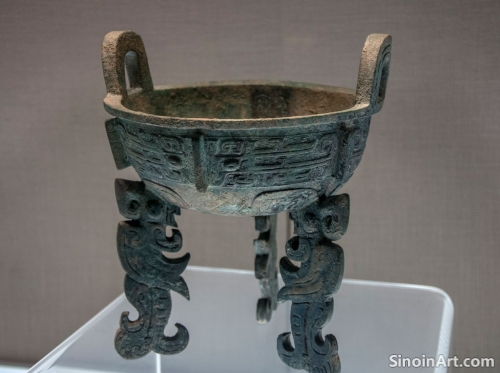The Influence of Zhou Dynasty Ritual Bronzes on Later Chinese Art and Culture
|
The ritual bronzes of the Zhou Dynasty, with their unique forms, complex inscriptions, and powerful symbolism, had a lasting impact on the development of later Chinese art and culture, shaping not only material culture but also the values and ideologies that would become central to Chinese society. The lasting influence of the Zhou dynasty on the art and cultural practices of later Chinese civilizations has been profound and far reaching.  The forms of Zhou bronze vessels, such as the ding, gui, and zun, were often replicated in later ceramics, jade carvings, and other media, demonstrating their lasting influence on Chinese design aesthetics. The basic forms of these objects were seen to possess both beauty and balance, making them a powerful design element.  The use of inscriptions on bronze also helped to establish the importance of the written word and the power of language as a means of conveying historical narratives and reinforcing cultural values. The use of language on bronzes also helped to shape both the development of the written word and also the concept of history.  The emphasis on ritual and ancestral veneration, which were deeply intertwined with the use of bronze in the Zhou Dynasty, continued to be important components of later Chinese religious and cultural practices, emphasizing the link between ritual, the past, and the present. The practices established during the Zhou dynasty continued to shape later culture and tradition. The study of Zhou bronze ware and its lasting influence provides a unique opportunity to connect with the artistic, cultural, and political foundations of ancient China, which continue to be relevant to this day. These powerful and lasting elements of Chinese culture helped to shape the society that we know today. |
Tag : Zhou bronze legacy, Chinese art history, cultural influence, ritual practices, ancestral veneration
Related information
- The Use of Bronze in Ancient Chinese Textile Production: Tools and Decorative Elements
- The Use of Bronze in Ancient Chinese Maritime Activities: Navigation, Trade, and Exploration
- Bronze Ware and the Development of Ancient Chinese Hydraulic Technology: Pumps, Pipes, and Control Mechanisms
- The Use of Bronze in Ancient Chinese Food Preparation and Dining: Utensils and Vessels
- A Guide to Further Study: Navigating the World of Chinese Bronze Ware Resources
This article explores the use of bronze in ancient Chinese textile production, highlighting its role in creating tools like hooks and needles, decorative elements like buckles, and revealing the interplay of metalworking and textile craftsmanship.
This article explores the use of bronze in ancient Chinese maritime activities, highlighting its role in creating ship fittings, navigational tools, and its impact on the development of trade routes and maritime exploration.
This article explores the use of bronze in ancient Chinese hydraulic technology, highlighting its role in creating pumps, pipes, valves, and other control mechanisms, and its importance in water management and technological innovation.
This article explores the use of bronze in ancient Chinese food preparation and dining, highlighting the creation of cooking pots, serving utensils, and tableware, and demonstrating how bronze was integrated into both daily life and social customs.
This article provides a guide to further study on Chinese bronze ware, highlighting academic journals, museum websites, online collections, and books, and providing a roadmap for continued exploration and research into this fascinating area of art and culture.